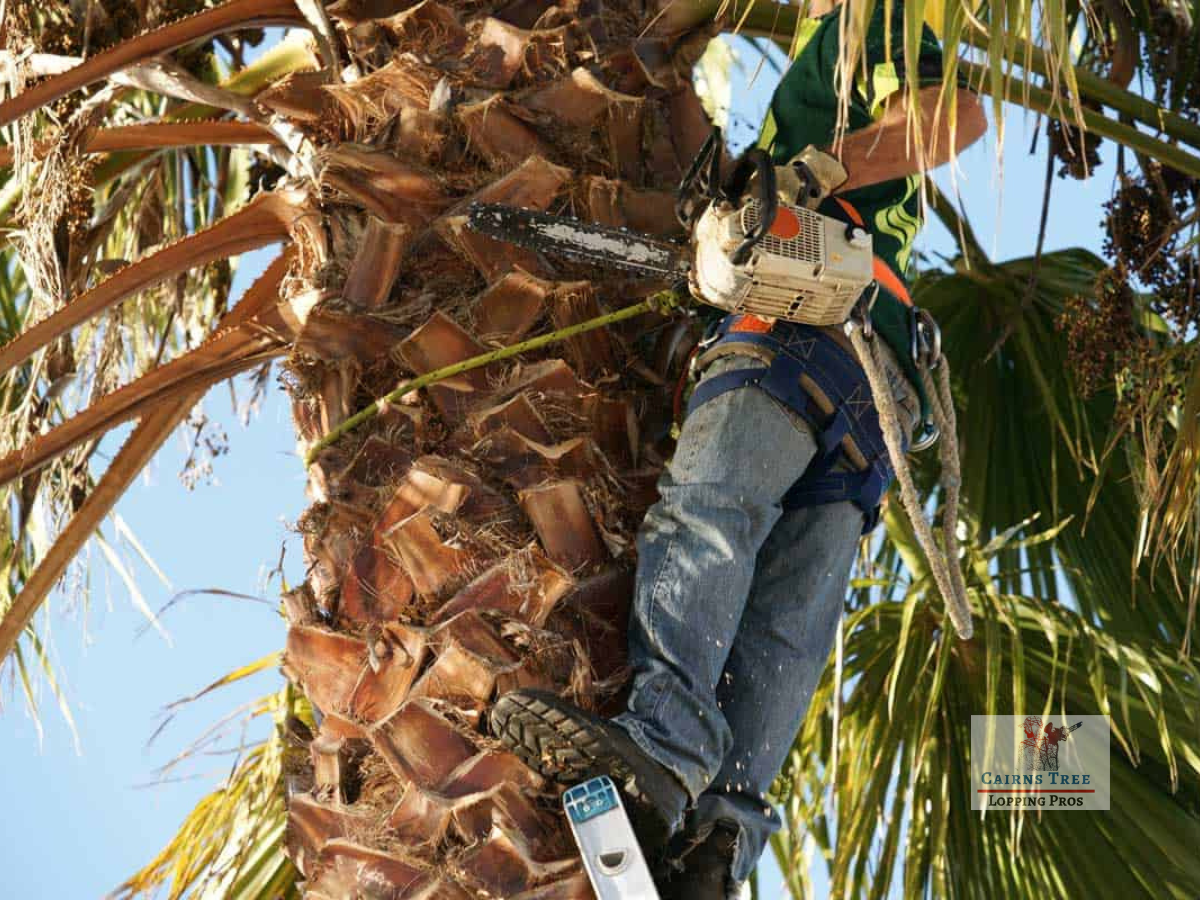Are you familiar with the benefits of regular palm tree management and care? If not, you’re in for a treat! Palm trees are some of the most beautiful and majestic plants around, and they offer a range of benefits to both homeowners and business owners. In this post, we’ll discuss some of the key reasons why it’s important to maintain your palm trees regularly. We’ll also provide tips on how to get the most out of your palm tree care regimen. Regular palm tree care and maintenance is essential for preserving their health and longevity. By taking a few simple steps, you can keep your palm trees looking great and protect them from common problems. This article will discuss the benefits of caring a palm tree.
Table of Contents
Benefits of Regular Palm Tree Management and Care
Did you know that regular palm tree maintenance and care can offer a variety of benefits? Palm trees are a beautiful and popular addition to many landscapes, but they require ongoing care in order to stay healthy and looking their best. By taking a few simple steps, you can enjoy your palm trees for many years to come. Here are just some of the benefits of proper palm tree management and care:
1) Healthy palms look better and add value to your property.
2) Well-maintained palms are resistant to pests and diseases.
3) Proper watering, fertilizing, and pruning will help your palms grow strong and healthy.
4) Regular trimming will keep your palms looking neat and tidy.
5)Palms provide shade and cooling relief from the heat during summer months.
6) Properly installed windbreaks can protect your palms from damage during storms.
7) improperly maintained palms can be costly to repair or replace. By following these tips, you can avoid costly mistakes, keep your palms looking great, and enjoy all the benefits they have to offer!

The Basics of Palm Tree Care
Palms are one of the most popular types of trees to grow in home landscapes. The slow-growing plants can add a touch of the tropics to any yard, and they are relatively easy to care for. The key to keeping a palm healthy is to provide it with the right growing conditions. Most palms prefer warm, humid climates and well-drained soil. They also need full sun to partial shade and regular watering. Palm trees are relatively low-maintenance, but they will need occasional pruning to remove damaged or dead leaves. With proper care, palms can provide years of beauty and enjoyment.
- Watering
Watering a palm tree correctly is vital to its health and appearance. If you water your palm tree too little, the leaves will begin to turn yellow and eventually brown and drop off. If you water your palm tree too much, the roots will rot, and the tree will eventually die. The best way to water a palm tree is to give it a deep watering once a week. Water should be applied slowly so that it has a chance to sink down to the roots. Be sure to check the soil regularly, and never let it dry out completely. With proper care, your palm tree will thrive for many years to come.
- Fertilizing
Fertilizing your palm tree is important to maintain its health and beauty. However, it’s important to Fertilize your palm tree correctly, as over-fertilizing can damage the tree. The best time to Fertilize your palm tree is in the springtime, before the growing season starts. You should also Fertilize your palm tree every six months to ensure that it gets the nutrients it needs. When Fertilizing your palm tree, be sure to use a fertilizer that is specifically designed for palms. This will help to ensure that your palm tree gets the nutrients it needs without being damaged by the fertilizer. Fertilizing your palm tree is an important part of maintaining its health and beauty, so be sure to do it correctly!
- Pruning
Pruning a palm tree is a necessary and beneficial task that should be performed on a regular basis. Not only does pruning help to keep the tree healthy and vibrant, but it also helps to improve its appearance. Pruning also encourages new growth, which can help to fill in any bare spots or areas of damage. When pruning a palm tree, it is important to remove any dead or dying fronds, as well as any that are significantly damaged. It is also important to trim back any overcrowded or overgrown fronds, as this will help to increase airflow and light exposure. Finally, be sure to cut away any fronds that are rubbing against each other, as this can damage the leaves and bark. With a little care and attention, pruning can help to keep your palm tree looking its best.
Specific Types of Palm Trees
Palm Trees are beautiful, tropical plants that can make any garden or backyard look like a paradise. There are many different varieties of palm trees, each with its own unique features. Some of the most popular types of palm trees include the Royal Palm, Coconut Palm, and Date Palm. The Royal Palm is one of the tallest types of palm trees, reaching heights of up to 100 feet. It has a slender trunk and long, graceful leaves that are often used in landscaping projects. The Coconut Palm is another tall variety, reaching heights of up to 80 feet. It produces coconuts, which can be used for food or as decoration. The Date Palm is shorter than other types of palm trees, only reaching heights of 20-30 feet. It produces a sweet fruit that is often used in baking and cooking. No matter what type of palm tree you choose, you are sure to add beauty and interest to your home or garden.
- Phoenix palm trees
Phoenix palm trees are a popular choice for landscaping in warm climates. Phoenix palms are tall, elegant trees that can add a touch of luxury to any property. These trees are also relatively low-maintenance, making them a good choice for busy homeowners. Phoenix palms are native to the Canary Islands, but they can be found in many tropical and subtropical regions around the world. These trees thrive in hot, dry conditions and can tolerate full sun. Phoenix palms are also salt-tolerant, making them a good choice for coastal properties. If you’re looking for a tree that will make a statement in your yard, Phoenix palm trees are a great option.
- Queen palm trees
Queen palm trees are one of the most popular types of palm trees. They are native to South America, but they can now be found in warm climates all over the world. Queen palms are identifiable by their long, slender trunk and their fronds, which can grow up to 20 feet long. Queen palms are also very fast-growing; they can add up to 2 feet of height every year. Queen palms are low-maintenance trees that require little care; however, they do need regular watering and fertilizing to stay healthy. Queen palms are an excellent choice for anyone looking for a graceful, easy-care tree for their landscape.
- Parlor palm trees
Parlor palm trees are one of the most popular types of houseplants, and it’s easy to see why. These beautiful plants add a touch of elegance to any room, and they are relatively easy to care for. Parlor palm trees are indigenous to Central America, and they thrive in warm, humid environments. When grown indoors, they should be placed in a south- or west-facing window, where they will receive bright indirect light. Parlor palm trees prefer moist soil, so be sure to water them regularly. Allow the top inch of soil to dry out between watering, and fertilize your plant every month during the growing season. With a little care, your parlor palm tree will provide you with years of enjoyment.
Diseases and Pests that Affect Palm Trees
Gardeners who are fortunate enough to live in a climate that supports palm trees often find that these tropical plants make a wonderful addition to the landscape. However, palm trees are not without their problems. Diseases and pests can cause serious damage to these plants, and even lead to death. Some of the most common problems include scale, mealybugs, and aphids. Diseases such as exfoliation and bud rot can also wreak havoc on palm trees. In order to keep these plants healthy, it is important to be on the lookout for signs of trouble. Symptoms such as yellowing leaves or stunted growth can be an indication that something is wrong. Bycatch early, gardeners can often take steps to prevent serious damage from occurring.
How to Deal with These Issues
The first step in dealing with any issue is to identify what the issue is. Once you know what the problem is, you can begin to look for solutions. If the issue is something that you can fix yourself, then great! If not, then you may need to seek out professional help. Either way, the important thing is to take action and not to ignore the problem.
Another important step in dealing with issues is to communicate with those involved. If the issue is with a friend or family member, have a talk with them and try to work things out. If the issue is at work, talk to your boss or human resources department. The key is to communicate openly and honestly in order to find a resolution.
Lastly, remember that issues are often temporary and can be resolved. Don’t let one problem cause you undue stress or anxiety. Instead, focus on finding a solution so that you can move on and enjoy your life.
When Is It Time to Remove a Palm Tree From Your Landscape
Palms are a classic staple in many landscapes. They are easy to care for and add an instant touch of tropical beauty. However, there may come a time when you need to remove a palm tree from your property. Whether it has become overgrown or diseased, removing a palm tree can be a daunting task. Here are a few things to consider before taking on this project:
First, assess the size of the tree. If the tree is small enough, you may be able to remove it yourself. However, if the tree is large, you will need to hire a professional tree service.
Second, consider the location of the tree. If the tree is near power lines or other structures, you will need to take extra precautions to avoid damage.
Finally, evaluate the health of the tree. If the tree is diseased or dying, it may be best to remove it before it becomes a safety hazard. With these factors in mind, you can determine whether removing a palm tree is the best option for your landscape.
Conclusion
Palm trees are a beautiful addition to any landscape, and with regular maintenance and care, they can provide years of enjoyment. If you’re in the market for a tree service company that can take care of your palm trees, we would be happy to recommend one. Let us know in the comments below what type of services you are looking for and we’ll do our best to help.
References:
Care and Maintenance of Palm Trees

